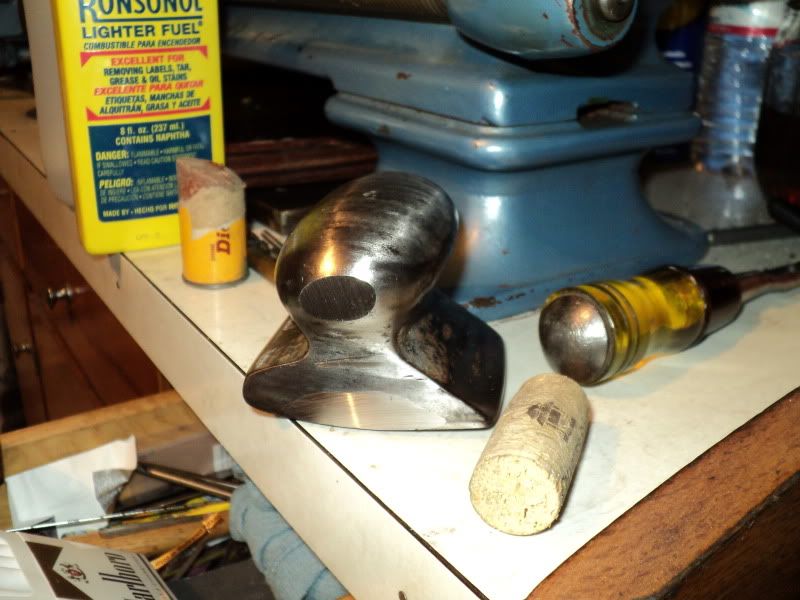Results 11 to 20 of 41
Thread: collarless pinning of Ivory
-
06-16-2011, 03:00 AM #11
 The white gleam of swords, not the black ink of books, clears doubts and uncertainties and bleak outlooks.
The white gleam of swords, not the black ink of books, clears doubts and uncertainties and bleak outlooks.
-
The Following User Says Thank You to onimaru55 For This Useful Post:
sharptonn (06-16-2011)
-
06-16-2011, 03:17 AM #12

Great idea! I have used layers of tape to protect scales in the past. This makes sense! Thx
"Don't be stubborn. You are missing out."
I rest my case.
-
06-16-2011, 03:33 AM #13
-
06-16-2011, 03:44 AM #14Senior Member


- Join Date
- Jan 2011
- Location
- Roseville,Kali
- Posts
- 10,432
Thanked: 2027
Dimpling block would be nice,But I'm cheap,body and fender dolly,auto parts store < 5bux.
poke some dimples in it of various sizes with drill bits,done,works for me.

-
-
06-16-2011, 03:23 PM #15

I found it! Knew it was in that cabinet!
Now I have a picture in my head.........Me, holding the razor on this rocking thing with one pin in a dimple while holding a nailset, while tapping with a hammer! I have 4 hands, no sweat!
I think I will start with grinding the bottom of the dolly until it sits nice and stable. Some technique will be necessary! If I can figure this out, I can complete lots of projects!"Don't be stubborn. You are missing out."
I rest my case.
-
06-16-2011, 03:28 PM #16Senior Member


- Join Date
- Jan 2011
- Location
- Roseville,Kali
- Posts
- 10,432
Thanked: 2027
If You have a disc sander,just lay the flat part of the dolly on the table and push.have fun

-
06-16-2011, 03:35 PM #17


- Join Date
- May 2005
- Location
- St. Louis, Missouri, United States
- Posts
- 8,454
- Blog Entries
- 2
Thanked: 4942
-
The Following User Says Thank You to Lynn For This Useful Post:
sharptonn (06-17-2011)
-
06-16-2011, 03:50 PM #18Senior Member


- Join Date
- Jan 2011
- Location
- Roseville,Kali
- Posts
- 10,432
Thanked: 2027
Ivory is actually alot tougher than most people realize,but the possibiliy of disaster is real for sure.
While on the subject,I restore clocks as a hobby,alot of clock makers tools are very usefull in Razor restoration,such as clock hand removal tools,Cannot be beat for a gentle way of removing old bent pins,another real possibility for cracking scales.

-
The Following User Says Thank You to pixelfixed For This Useful Post:
Caledonian (06-18-2011)
-
06-17-2011, 05:58 PM #19

I agree, why should they have to be collarless? I've just been making my own turned rivets from sterling silver, for an 1830s razor for which nickel silver is probably out of period. It is soft and easily peened, and probably needs to be a bit larger to obtain adequate strength. I found that the junction between pin and collar became completely invisible.
You can get telescoping sizes of brass tube in many model-making shops and probably on eBay, and the chances of cracking should be much lessened by using not just a washer, but a piece of tubing epoxied in for the full thickness of the scale.
I liked the idea of a concave punch to finish off the rivet, but that, because it bears on a large area, would require to be whacked rather harder than the usual large number of taps with a light hammer. So it would still have to be used with caution, and I think its main function would be ensuring perfect roundness for a rivet and collar already worked on with the hammer.
With me it isn't clocks, but antique pocket watches. This picture is a staking set, which is like a tiny drill press with no motor, used for hitting vertically aligned punches with a hammer. Complete sets are very expensive, but you will find part-sets cheap if you watch eBay for a while. I haven't seen a punch with a cup-shapped recess, but one could be made, 3/16in. steel rod being the common size.
I would position the carbide or diamond round-nosed burrs I have for use with my Dremel tool, in one of the holes in the staking-tool table. Or I would temporarily epoxy something onto the table to hold a small ball-bearing, and hammer the annealed steel punch against the bearing to make the hollow. Using one of the holes in the table to hold the bearing would damage its edges.
-
06-17-2011, 11:39 PM #20

While we are on the subject, why are most ivory scales washerless? Is there a reason for it? I would have thought that if ever a material needed a washer it would be a thin natural one prone to cracking.


 36Likes
36Likes LinkBack URL
LinkBack URL About LinkBacks
About LinkBacks








 Reply With Quote
Reply With Quote

